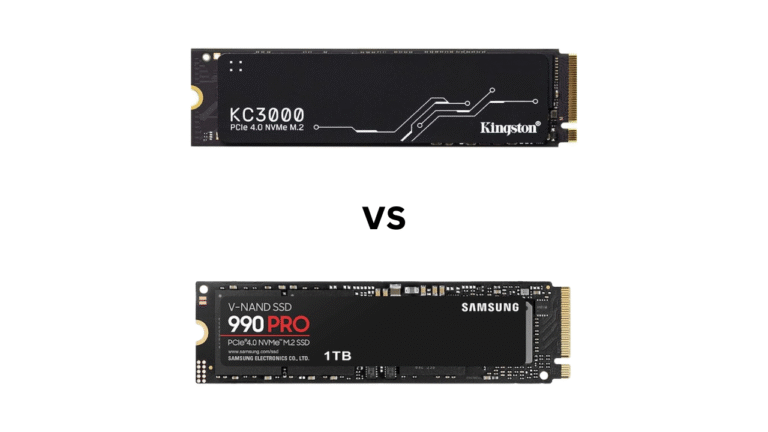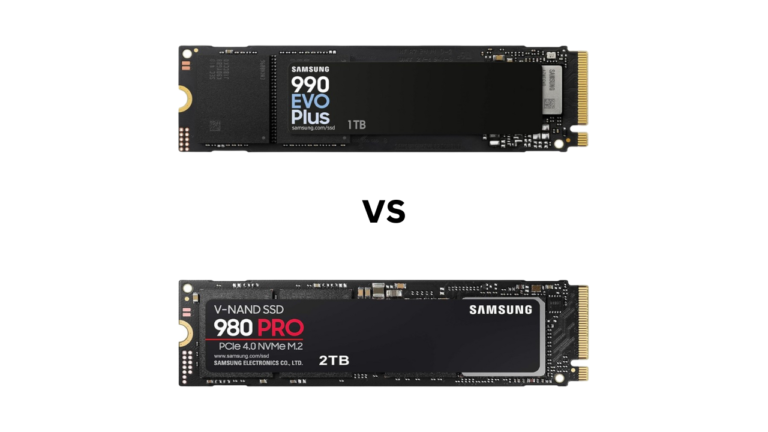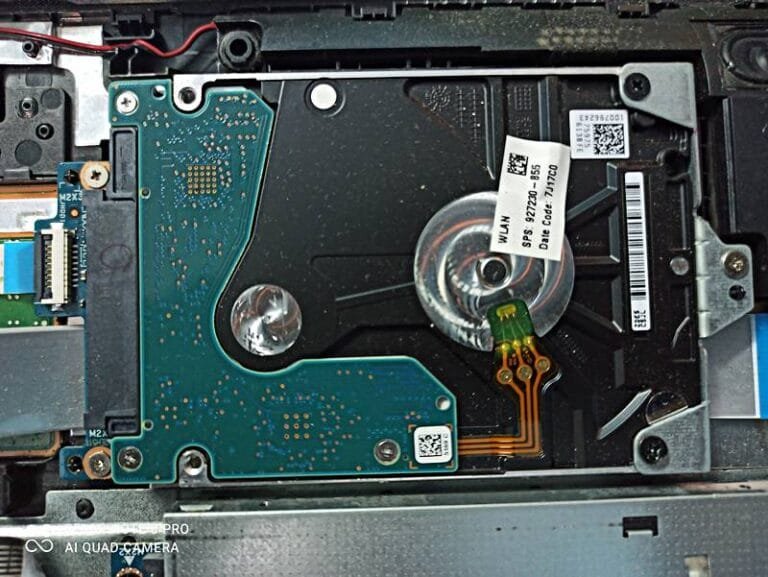Affiliate Disclosure: This post may include affiliate links. If you click and make a purchase, I may earn a small commission at no extra cost to you.
I have compared the Samsung 990 EVO Plus and the WD Black SN770 across different SSDs. But recently, I was getting many requests for a good comparison of these two.
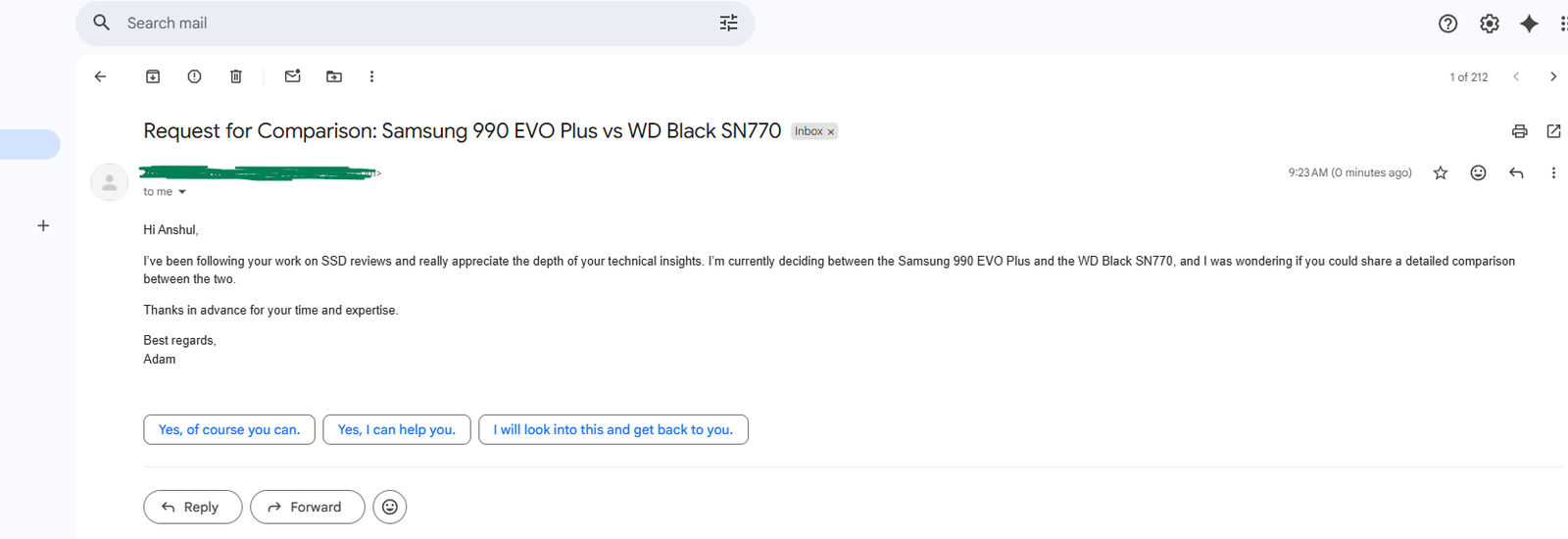
Here is a detailed comparison of both SSDs if you are also confused between the two. Both of these are mid-range NVMe drives. Both are Gen 4.0 x4 drives, but the 990 EVO Plus also supports Gen 5.0 x2 (half Gen 5.0). Generally, NVMe drives use 4 PCIe lanes for data transmission. But, because the 990 EVO Plus isn’t a full Gen 5.0 drive, it can use just two lanes and have all the bandwidth it requires. The performance remains almost the same, no matter which configuration you use.
First of all, both SSDs are DRAM-less and use HMB (Host Memory Buffer). With this tech, these SSDs use a small portion of the system’s memory primarily to handle the mapping tables. This allows brands to reduce costs, power consumption, and overall heat in their low-end drives. However, there are some issues with DRAM-less SSDs that you can check out here.
The Samsung 990 EVO Plus has a much superior, denser V8 V-NAND flash, while the SN770 comes with somewhat inferior Kioxia BiCS5 NAND. If you don’t know, NAND is where the data is actually stored in the SSDs. So, Samsung’s NAND offers better raw read/write speeds and lower latency than the SN770.
The Piccolo controller in the 990 EVO Plus is much more efficient, based on the 5nm process. It comes with four flash channels running at 2400 MT/s each. However, the SN770 has Polaris MP16+ controller, based on 16nm process, which means it is less refined and efficient. It also has four flash channels running at 1,600 MT/s each. It is good that both brands have their own controllers, which means better firmware optimization. But Samsung has something better to offer here as well.
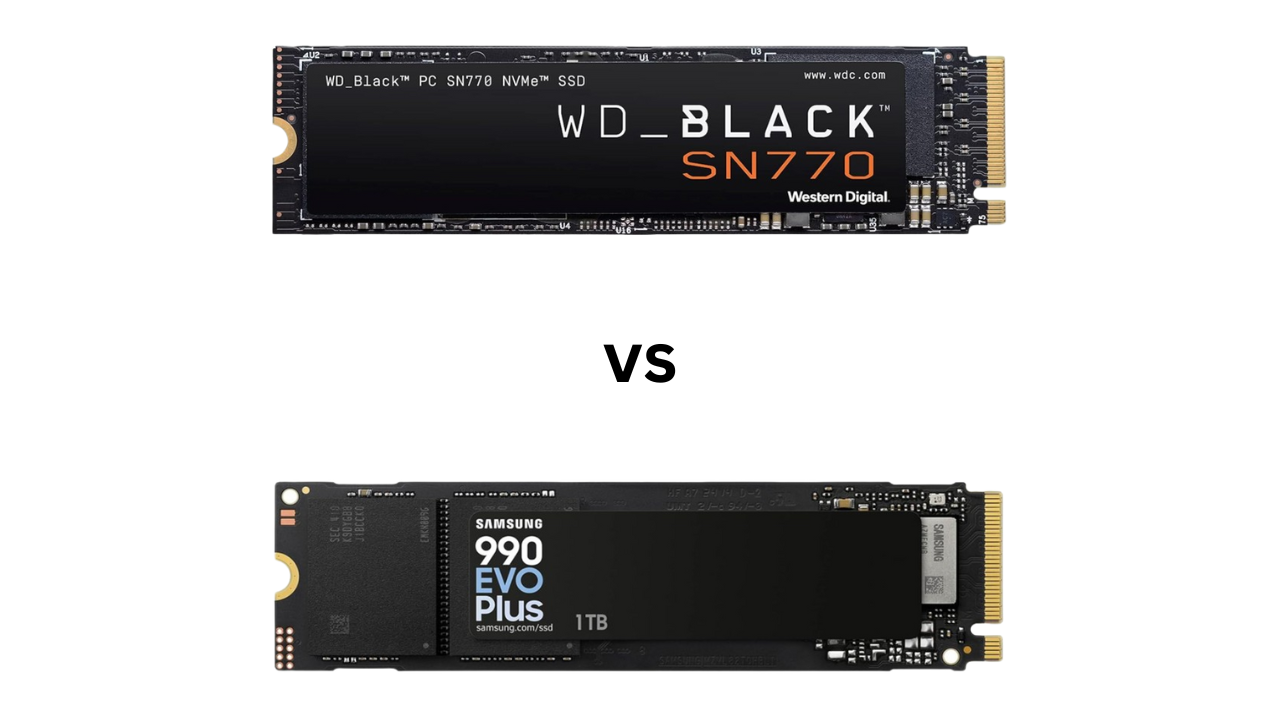
There are other differences and similarities between these drives that we will cover in this article, including benchmarks. So, without any delays, let’s get started.
Theoretical Specifications Comparison
| Specification | WD Black SN770 | Samsung 990 EVO Plus |
|---|---|---|
| PCIe Generation/NVMe Version | PCIe Gen 4.0 x4 / NVMe 1.4 | PCIe Gen 4.0 x4, Gen 5.0 x2 / NVMe 1.4 |
| Release Date | February, 2022 | Sep, 2024 |
| Capacities | 250GB, 500GB, 1TB, 2TB | 1TB, 2TB, 4TB |
| Sequential Read Speed | 250GB: 4,000 MB/s 500GB: 5,000 MB/s 1TB: 5,150 MB/s 2TB: 5,150 MB/s | 1TB: 7,150 MB/s 2TB: 7,250 MB/s 4TB: 7,250 MB/s |
| Sequential Write Speed | 250GB: 2,000 MB/s 500GB: 4,000 MB/s 1TB: 4,900 MB/s 2TB: 4,850 MB/s | 1TB: 6,300 MB/s 2TB: 6,300 MB/s 4TB: 6,300 MB/s |
| Random Read Speed | 250GB: 240K IOPS 500GB: 460K IOPS 1TB: 740K IOPS 2TB: 650K IOPS | 1TB: 850K IOPS 2TB: 1,350K IOPS 4TB: 1,050K IOPS |
| Random Write Speed | 250GB: 470K IOPS 500GB-2TB: 800K IOPS | 1TB: 1,350K IOPS 2TB: 1,350K IOPS 4TB: 1,400K IOPS |
| NAND Flash | Kioxia BiCS5 TLC (112-layer) | Samsung’s V8 V-NAND TLC (236-layer) |
| DRAM | No (HMB) | No (HMB) |
| Price (MSRP) | 1TB starting from 75.99$ | 1TB starting from 84.99$ |
In terms of capacity, both drives have their own advantages. The SN770 offers two low-capacity options of 250GB and 500GB, whereas the 990 EVO Plus doesn’t. However, the 990 EVO Plus offers a 4TB variant that the SN770 lacks.
The theoretical read/write speeds in both sequential and random performance are higher with the 990 EVO Plus. We will see whether the 990 EVO Plus actually offers a better performance in the benchmarks below.
Benchmark Scores Comparison
All the benchmark scores are for the 2TB variants of both drives.
PCMark 10 Full Drive Benchmark
PCMark 10 Full System Drive Benchmark runs a set of everyday tasks that mimic real PC use. It tests your drive as the primary OS drive. The test may include tasks like loading apps. photo editing, video editing, file editing, etc. The PCMark score is a single score that summarizes overall real-world performance. Bandwidth shows how much data the drive can move per second, and latency measures how quickly the drive responds to requests.
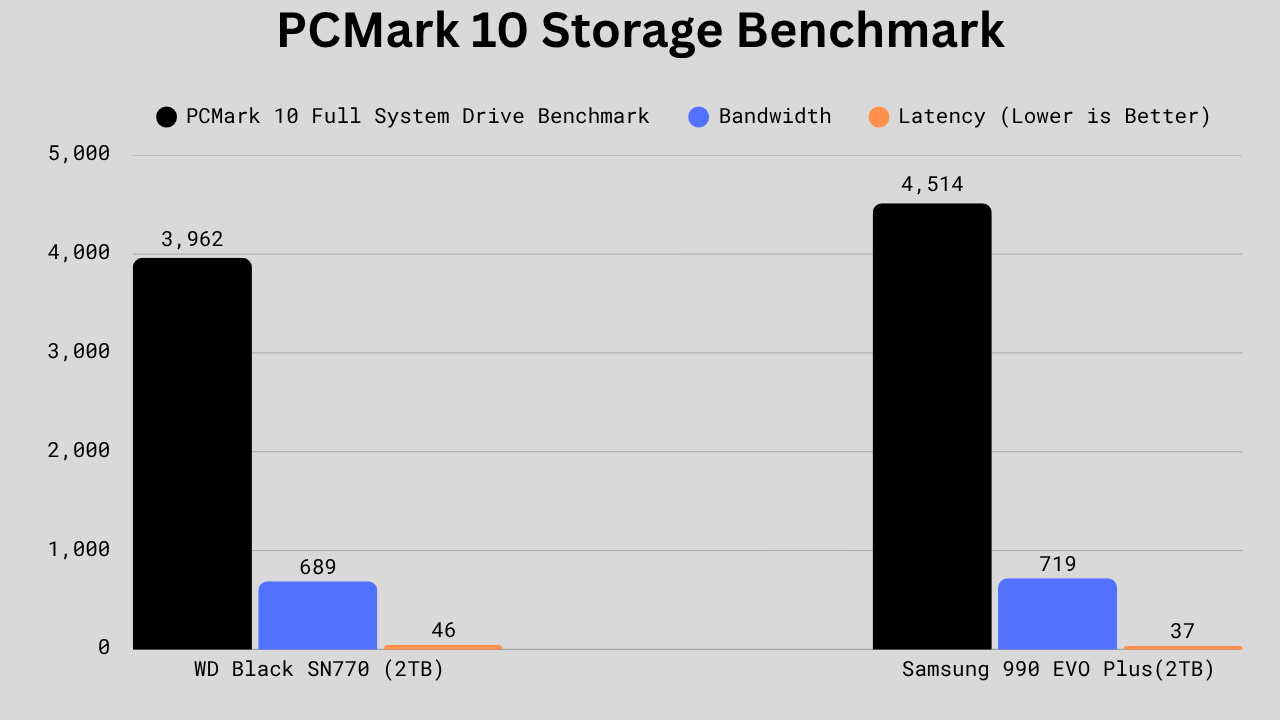
Samsung 990 EVO Plus scores 4,514 on the PCMark 10 full-system drive benchmark, versus WD Black SN770’s 3,962, a lead of 552 points, or about 13.9% higher for Samsung. On raw bandwidth, the EVO Plus is also ahead, 719 MB/s versus 689 MB/s, a small advantage of 30 MB/s or roughly 4.4%. Latency (lower is better) favors the Samsung by 9 microseconds, 37 µs versus 46 µs, which is about a 19.6% lower latency. In short, the 990 EVO Plus is measurably faster across the board here, with its biggest advantage in the overall PCMark score and latency; the WD is close on bandwidth but trails on
3DMark Storage Test for Gamers
The 3DMark storage benchmark tests your drives gaming capabilities by running several gaming-related tasks such as game installing, loading, saving, streaming etc. It also gives the scores with the total score, bandwidth, and latency. Higher numbers generally mean a better gaming performance from an SSD.

Samsung’s 990 EVO Plus dominates this 3DMark Storage result as well. Its overall score is 4,753 versus the WD SN770’s 3,516, a lead of 1,237 points or about 35.2% higher. Bandwidth shows an even bigger gap: 818 MB/s for the Samsung against 556 MB/s for the WD, a difference of 262 MB/s or roughly 47.1% more throughput. Latency (lower is better) also favors Samsung at 38 µs versus 48 µs for the SN770, a 10 µs improvement or about 20.8% lower latency. In short, the EVO Plus is substantially faster in score and will offer a better gaming experience.
CrystalDiskMark Sequential Read/Write Performance
These tests measure the peak sequential read and write speeds. It replicates how quickly a drive can move large, continuous files, such as videos or game installs. QD8 means the test uses multiple queued requests, representing heavy workloads, while QD1 mimics lighter, everyday use. Higher numbers mean faster large-file performance and better sustained throughput.
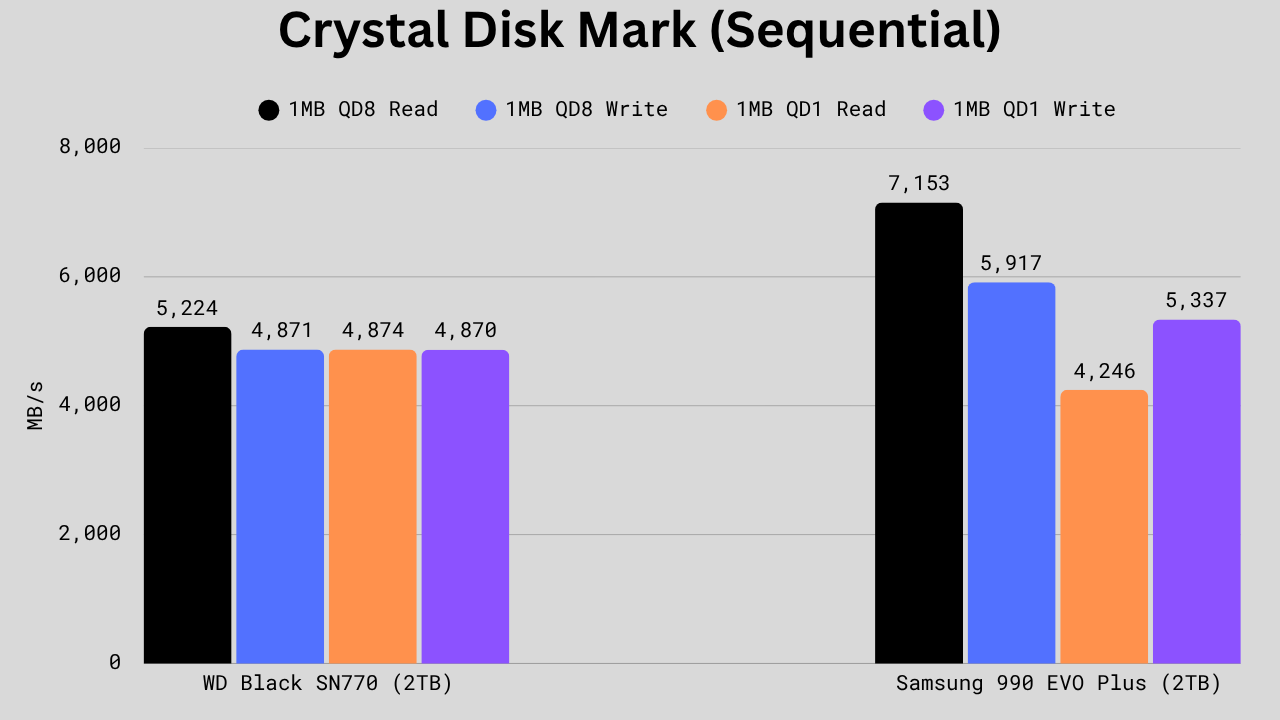
The Samsung 990 EVO Plus clearly leads in three of the four tests. It delivers about 37% higher 1MB QD8 read speed (7,153 vs 5,224 MB/s) and roughly 21% better QD8 write performance (5,917 vs 4,871 MB/s). It also edges out in 1MB QD1 write speed, 5,337 vs 4,870 MB/s. The only test where the WD Black SN770 comes out slightly ahead is the 1MB QD1 read, scoring 4,874 MB/s compared to Samsung’s 4,246 MB/s, giving WD a 15% lead in that single, low-queue read scenario. That suggests the SN770 might perform a bit better on simple, single-threaded workloads, but the EVO Plus wins decisively under heavier, multi-queue workloads.
CrystalDiskMark Random Read/Write Performance

In a small-block 4KB performance test, which reflects how fast a drive handles tiny everyday data requests, the Samsung 990 EVO Plus again has better performance to offer. It delivers roughly 16.5% faster 4KB QD1 read speed (23,221 vs 19,929 IOPS) and a massive 61% higher 4KB QD256 read (1,020,985 vs 633,499). Write performance at high queue depth also favors Samsung with a 65% lead (1,271,189 vs 770,672). The only area where the WD Black SN770 wins is in 4KB QD1 write, where it posts 96,315 IOPS compared to Samsung’s 84,468. This clearly means the EVO Plus shines in multitasking and heavy random workloads, while the SN770 can be better at low-depth writes.
File Transfer Rate
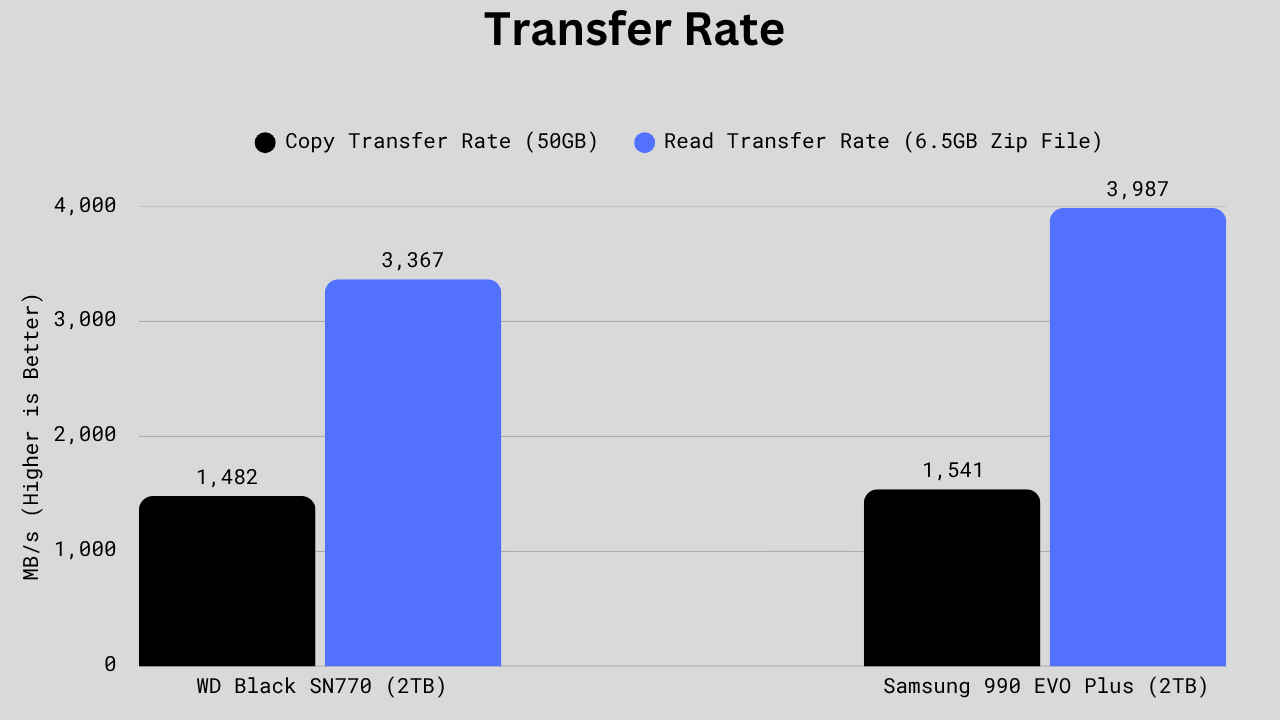
In these real-world transfer tests, the Samsung 990 EVO Plus holds a modest but consistent lead. It copies a 50GB file at 1,541 MB/s, about 4% faster than the WD Black SN770’s 1,482 MB/s. The advantage is more pronounced in the read test with a 6.5GB zip file, where Samsung hits 3,987 MB/s versus WD’s 3,367 MB/s. These results show that Samsung’s controller and cache setup handle both sustained and compressed data more efficiently. The SN770 still performs well, especially given its price, but it’s clearly a step behind in heavy file handling.
Power Consumption and Efficiency
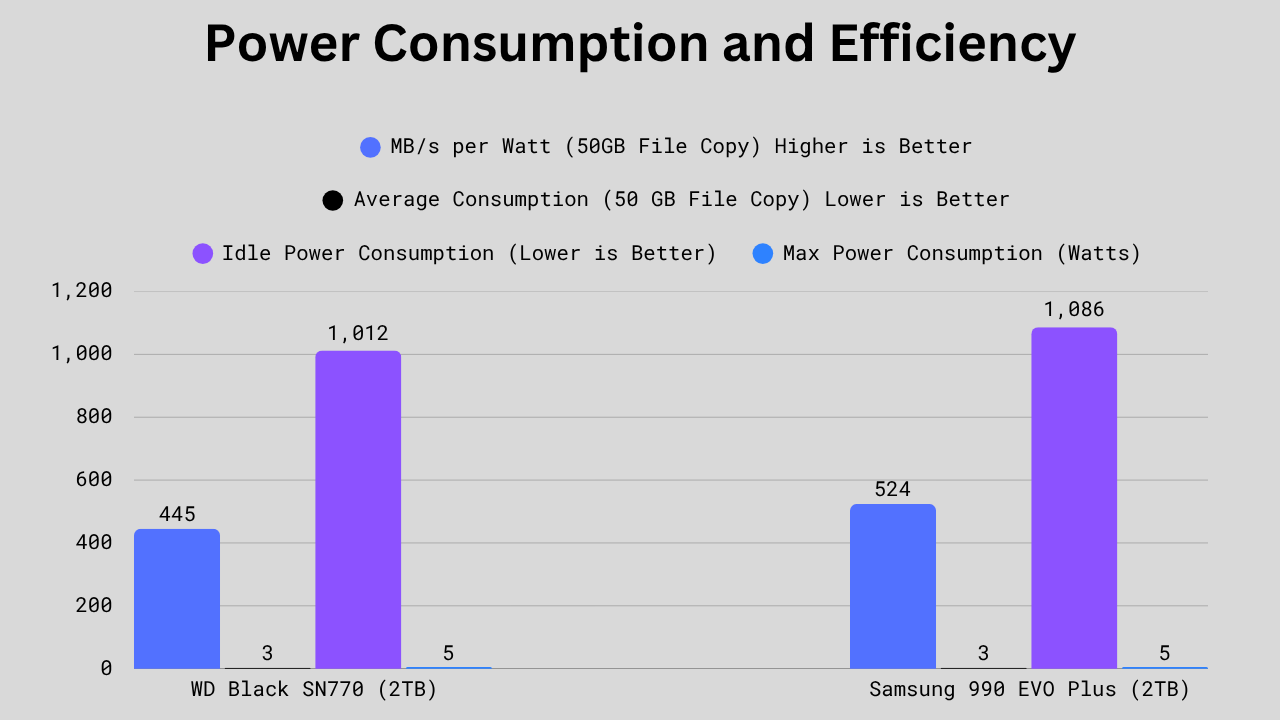
In terms of efficiency, the Samsung 990 EVO Plus shows a clear edge in throughput per watt. It offers 524 MB/s per watt, compared to the WD Black SN770’s 445, roughly an 18% improvement in energy efficiency during large-file copies. Both drives draw about the same average power (3 W) and hit the same maximum power of 5 W, so Samsung achieves better efficiency by moving more data without consuming extra energy. The SN770 is slightly more frugal at idle, drawing 1,012 mW vs Samsung’s 1,086 mW, a minor difference that might matter only in laptops. Overall, both drives are well-tuned, but Samsung squeezes out more work per watt.
TBW, DWPD, MTBF, and Warranty
| Specification | WD Black SN770 | Samsung 990 EVO Plus |
|---|---|---|
| Endurance (TBW) | 250GB: 150 TBW 500GB: 300 TBW 1TB: 600 TBW 2TB: 1,200 TBW | 1TB: 600 TBW 2TB: 1,200 TBW 4TB: 2,400 TBW |
| Warranty | 5 Years | 5 Years |
| DWPD (Drive WRites per Day) | 0.3 | 0.3 |
| MTBF (Mean Time between Failure) | 1.8 Million Hours | 1.5 Million Hours |
The TBW and DWPD are identical across the matching variants of both SSDs. Also, the warranty of 5 years is the exact same. However, the SN770 gives a higher mean time between failure of 1.8 million hours compared to the 990 EVO Plus’s 1.5 million hours. So, it might not seem too big of a deal but the SN770 has got an advantage there.
Technical Specifications
| Specification | WD Black SN770 | Samsung 990 EVO Plus |
|---|---|---|
| Controller | WD 20-82-10081-A1 Polaris MP16+ | Samsung Piccolo (S4LY022) |
| Controller Architecture | ARM 32-bit Cortex-R | ARM 32-bit Cortex-R8 |
| Process | 16 nm | 5 nm |
| DRAM Specifications | DRAM-Less (64MB HMB) | DRAM-Less (64MB HMB) |
| SLC Write Cache | 250GB: – 500GB: – 1TB: approx. 377 GB (dynamic only) 2TB: approx. 740 GB(dynamic only) | 1TB: approx. 114 GB (108 GB Dynamic + 6 GB Static) 2TB: approx. 226 GB (216 GB Dynamic + 10 GB Static) 4TB: approx. 442 GB (432 GB Dynamic + 10 GB Static) |
| NAND Flash | BiCS5 TLC 3D NAND (112-layer) | Samsung’s V-NAND V8 |
| NAND speed | 1,200 MT/s | 2400 MT/s |
| Encryption | None | AES-256, TCG Opal |
| SMART/TRIM/PS5 Support | Yes/Yes/Yes | Yes/Yes/Yes |
| Heatsink Variant | Not Available | Not Available |
| Datasheet | SN770 | 990 EVO Plus |
On the hardware side, the Samsung 990 EVO Plus has a more advanced design across nearly every technical aspect. As we discussed earlier, its controller, the Piccolo (S4LY022), is based on a 5 nm ARM Cortex-R8 architecture, which is much newer and more efficient than the WD SN770’s 16 nm Cortex-R chip.
Samsung’s V-NAND V8 also runs at 2,400 MT/s, doubling the NAND interface speed over WD’s 1,200 MT/s BiCS5 TLC. Both drives are DRAM-less and rely on a small 64 MB HMB buffer, but Samsung’s larger, partly static SLC cache (226 GB for 2 TB vs WD’s 740 GB dynamic-only cache) provides more predictable sustained write performance. The 990 EVO Plus also includes AES-256 and TCG Opal encryption, something the SN770 lacks, making it better for users who value data protection.
Price
By the time I write this article, the 1TB SN770 is selling for $75.99 at Newegg. The 1TB 990 EVO Plus, on the other hand, is available for 84.99$. So, there is a difference of about $10. But this price difference is reduced to around 2$ at 2 TB. So, the SN770 is cheaper only in the 1TB variant, and I would say this saving is good enough for most users. However, these prices keep changing and you should check them on different marketplaces before you make your final purchase.


Conclusion: Which One Should You Choose?
All in all, the Samsung 990 EVO Plus is technically superior with faster NAND, a more advanced controller, and encryption support, making it ideal for professionals or power users. In terms of gaming and overall performance, it offers more. Being a DRAM-less drive, the 990 EVO competes with high-end drives like the 990 Pro in terms of performance. Surely, there are drawbacks to not having DRAM, but there are benefits as well, such as lower power consumption and reduced heat generation. So, in this comparison, the 990 EVO Plus is the clear winner.
The SN770 is also a good pick, but in my opinion, you should buy it only if you are getting it at an excellent discount and the price difference has widened. I can still think about the 1TB variant of the SN770 because of its low price, but I would not buy the 2TB variant when I can get the 2TB 990 EVO Plus at the same price. At the same price, the 990 EVO Plus offers better features and performance. Even if you have to pay 5 to 10 bucks more for the 990 EVO Plus, it is definitely worth it.
I hope this helps!

